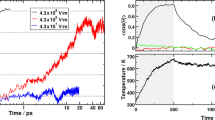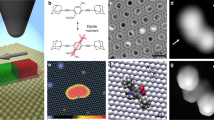Abstract
IN typical collisional or spectroscopic experiments, molecules rotate freely with random spatial orientations. The resulting isotropic averaging obscures or suppresses much stereodynamical information and has remained a recalcitrant problem. The only practical means for orienting a molecule itself, rather than just its axis of rotation, has been electric field focusing1,2. But this is applicable only to certain rotational states of symmetric top molecules (or equivalent) that exhibit a first-order Stark effect. Orientation of molecules other than symmetric tops has long been considered to be quite unfeasible3. Recently, however, it has been pointed out4,5 that by exploiting the extreme rotational cooling that can occur in supersonic molecular beams, substantial orientation of diatomic, linear or asymmetric top molecules should become possible at accessible field strengths. The anisotropy of the Stark effect allows molecules in the lowest few rotational states to be trapped in 'pendular states' and thereby confined to librate (oscillate about the field axis) over a limited angular range. Here we describe an experiment which demonstrates that oriented pendular states can be obtained for a diatomic molecule with modest field strengths. With anticipated improvements, this technique should become widely applicable.
This is a preview of subscription content, access via your institution
Access options
Subscribe to this journal
Receive 51 print issues and online access
$199.00 per year
only $3.90 per issue
Buy this article
- Purchase on Springer Link
- Instant access to full article PDF
Prices may be subject to local taxes which are calculated during checkout
Similar content being viewed by others
References
Brooks, P. R. Science 193, 11–16 (1976).
Parker, D. H. & Bernstein, R. B. A. Rev. phys. Chem. 40, 561–595 (1989).
Bernstein, R. B., Herschbach, D. R. & Levine, R. D. J. phys. Chem. 91, 5365–5377 (1987).
Loesch, H. J. & Remscheid, A. J. chem. Phys. 93, 4779–4790 (1990).
Friedrich, B. & Herschbach, D. R. Z. Phys. D18, 153–161 (1991).
Gandhi, S. R. & Bernstein, R. B. J. chem. Phys. 93, 4024–4032 (1990).
Harland, P. W., Carman, H. S., Phillips, L. F. & Brooks, P. R. J. chem. Phys. 93, 1089–1097 (1990).
Bulthuis, J., Milan, J. B., Janssen, M. H. M. & Stolte, S. J. chem. Phys. 94, 7181–7192 (1991).
Kaesdorf, S., Schönhense, G. & Heinzmann, U. Phys. Rev. Lett. 54, 885–887 (1985).
Macay, R. S., Curtiss, T. J. & Bernstein, R. B. J. chem. Phys. 92, 801–802 (1990).
Pullman, D. P., Friedrich, B. & Herschbach, D. R. J. chem. Phys. 93, 3224–3236 (1990).
Huber, K. P. & Herzberg, G. Molecular Spectra and Molecular Structure Vol. IV, 341 (Van Nostrand Reinhold, New York, 1979).
Cummings, F. E. & Klemperer, W. J. chem. Phys. 60, 2035–2039 (1974).
Coxon, J. A., Gordon, R. M. & Wickramaaratchi, M. A. J. molec. Spectrosc. 79, 363–379 (1980).
Hansen, S. G., Thompson, J. D., Western, C. M. & Howard, B. J. Molec. Phys. 49, 1217–1229 (1983).
Johnson, J. R., Slotterback, T. J., Pratt, D. W., Janda, K. C. & Western, C. M. J. phys. Chem. 94, 5661–5664 (1990).
Meyenn, K. Z. Phys. 231, 154–160 (1970).
Kais, S. & Levine, R. D. J. phys. Chem. 91, 5462–5465 (1987).
Friedrich, B., Pullman, D. P. & Herschbach, D. R. J. phys. Chem. 95 (1991).
Hsu, D. S. Y., Weinstein, N. D. & Herschbach, D. R. Molec. Phys. 29, 257–278 (1975).
Author information
Authors and Affiliations
Rights and permissions
About this article
Cite this article
Friedrich, B., Herschbach, D. Spatial orientation of molecules in strong electric fields and evidence for pendular states. Nature 353, 412–414 (1991). https://doi.org/10.1038/353412a0
Received:
Accepted:
Issue Date:
DOI: https://doi.org/10.1038/353412a0
This article is cited by
-
Universal machine learning for the response of atomistic systems to external fields
Nature Communications (2023)
-
Dependences of Q-branch integrated intensity of linear-molecule pendular spectra on electric-field strength and rotational temperature and its potential applications
Scientific Reports (2016)
Comments
By submitting a comment you agree to abide by our Terms and Community Guidelines. If you find something abusive or that does not comply with our terms or guidelines please flag it as inappropriate.



